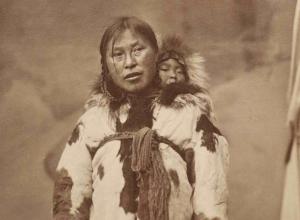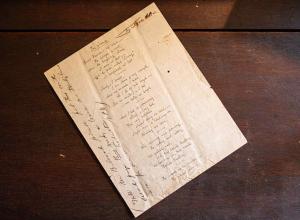Audrey Niffenegger on The Time Traveler's Wife, Book Design, and Collecting
 When I saw the news bit earlier this week that artist and novelist Audrey Niffenegger will be publishing a short story titled "The Wrong Faerie" in the upcoming anthology, Magic: An Anthology of the Esoteric and Arcane, I was beyond excited. The story is about Charles Altamont Doyle, "a Victorian artist who was institutionalised for alcoholism. He was also the father of Arthur Conan Doyle, and he believed in fairies." In short, it sounds fabulous already. Maybe I'm biased. As FB&C readers know, I traveled to Chicago this past summer to meet Niffenegger and discuss books, art, fame, and collecting. She also signed a few books for me. The result of that interview is our winter issue's cover story. But we talked a lot that day, and so there is more to share about our conversation.
When I saw the news bit earlier this week that artist and novelist Audrey Niffenegger will be publishing a short story titled "The Wrong Faerie" in the upcoming anthology, Magic: An Anthology of the Esoteric and Arcane, I was beyond excited. The story is about Charles Altamont Doyle, "a Victorian artist who was institutionalised for alcoholism. He was also the father of Arthur Conan Doyle, and he believed in fairies." In short, it sounds fabulous already. Maybe I'm biased. As FB&C readers know, I traveled to Chicago this past summer to meet Niffenegger and discuss books, art, fame, and collecting. She also signed a few books for me. The result of that interview is our winter issue's cover story. But we talked a lot that day, and so there is more to share about our conversation.
I asked her how her creative life has changed since the incredible success of The Time Traveler's Wife. Here is what she said:
Well, one of the things that changed a lot, I never used to have any money, so I never used to go anywhere...I got a lot done. With Time Traveler, I spent about three years running around doing festivals and promoting it, and with Symmetry, I spent about a year and a half, just solid running around, constantly away. And it's almost impossible to do real artwork in hotel rooms, so that has been kind of slowing me down. What I'm hoping to do in the next couple of years is not move around as much, get more centered. I've got big projects that I'm working on that have to get done with real deadlines, so I basically have no choice but to turn things down and make sure I get my work done. Time management is really the big problem. The monetary impediments were removed, but at the same time the time constraints became overwhelming. A lot of people are like, 'So that new novel, it must be done, right?' I'm like, 'no.' It's just difficult when you're constantly talking about the work you've already done to get the new work happening.
Niffenegger collects taxidermy and books. I asked her to talk a bit more about those collections.
The taxidermy is, in a way, not really a serious collection because it's just strange things that hang around the house, and you look at them and think, 'hmmm, that's really strange'... It's not like I'm a biologist and have great insight into all these creatures. I mean, in my collection, the more damaged they are, the more interesting. There are missing eyes and paws, looking really pathetic. Occasionally I'll buy a really glorious piece because it's interesting, but for the most part I buy very strange, cheap, damaged taxidermy. The taxidermy collection is completely eclectic and based on pathos and strangeness. The book collection, on the other hand, there's a very definite train of thought running through that collection. I am interested in books that use images and words together in interesting ways. So if something is typographically interesting, if it's telling an interesting story in a way where everything supports the story interestingly, if the illustrations are really spectacular or if it's going beyond illustration and into a wordless novel or something like that, I'm very interested in that.
I'm less interested in sculptural books. I mean, I have a few. I'm very interested in fine print, so, for example, I'm very fond of Arion Press, and I'm always sort of looking out for their things. I'm always interested in what my students and former students are doing, so I veer toward them when I can. Always partial to aquatints because it's what I myself do. I sometimes buy with an eye to showing my students things, so if I don't have a good example of a such-and-such, I will sometimes try to acquire one so that when I'm talking about such-and-such, I can say, 'and here is a such-and-such' and give them a better chance of understanding what the heck I'm talking about. Books are really hard to show in slides ... it's so much better if they can handle it, it just becomes a completely different experience.
 Audrey Niffenegger shows me her prints at Printworks Gallery in Chicago this past summer. Photo credit: Brett Barry.
Audrey Niffenegger shows me her prints at Printworks Gallery in Chicago this past summer. Photo credit: Brett Barry.
One question that many people ask is if, as an artist, she gets to design her own books and limited editions. Here is what she said:
For Time Traveler and for Symmetry, there were limited editions, and I got to design those. I did not get to design the commercial edition because everybody immediately agreed that I am not a very commercial artist, which is fine with me! The design for the cover of Time Traveler was done by Suzanne Dean who is the head designer at Random UK, and she did Symmetry in the UK. Scribner's designer Rex Bonomelli, he came up with the shiny, metallic, twiggy cover, which I liked tremendously. Then when it became a paperback, everyone was saying, 'there must be a person on the cover,' and I said, 'well, okay, but just don't cut off her head.' And so we went through lots of iterations of people with and without heads. I like what they came up with...
The limited editions are fun because they don't necessarily have to follow all the rules of conventional book design. Like the limited edition I did for Scribner for Symmetry, it doesn't even have the title on the spine, it the initials of the title and my initials, and if you had it spine-in, that's all you would be able to see. It's not the most readable typeface, the book is entirely black, so it's got lots of things going on that wouldn't scream 'buy me!'...A limited edition of a printed book made by commercial processes is a whole different deal than a real printing.















